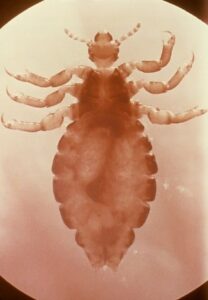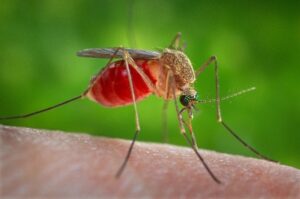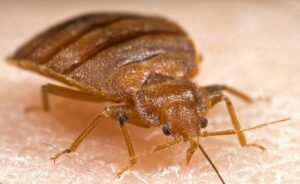Biting Midges or Ceratopogonids Midges:
General Description
|
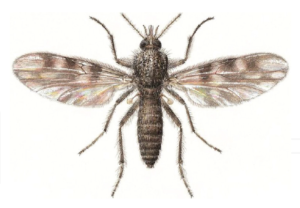
Credit: Slama, Babba. and Chaker Culicoides spp. |
- The antennae are densely feathery in the male and simple in the female.
- The piercing-sucking mouth parts are short and hang from the head.
- The eggs are brown in color and resemble bananas.
- The wings are short and relatively wide, with few veins and devoid of scales and hairs. There are usually specific black spots on the wing, alternating with white ones, as in the genus Culicoides (the most widespread genus), or the wings are white in color, such as milky, and in strong contrast with the black body, as in the genus Leptoconops. The wings intertwine at rest over the body like the blades of a scissor.
- Larvae are cylindrical in shape, small in size, and without legs. They are distinguished by the presence of a pair of four papillae on the last abdominal ring.
Life Cycle and Common Characteristics
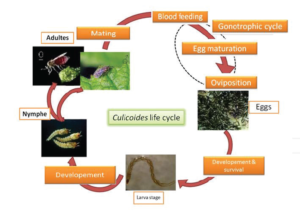
Culicoides spp. Credit: Slama, Babba. and Chaker – http://dx.doi.org/10.5772/66944 |
- Eggs are placed in groups in various moist environments, such as rotted plants, tree holes, animal dung, swamps, the mud of fresh and salt water, slow waterways, or sands of the sea coasts. Eggs hatch after 2-7 days.
- Larvae often develop in widespread and diverse habitats. They feed on decomposing plants and have four instars, which last from 2 to 3 weeks in hot areas. In cold regions, they spend the winter as larvae, and this may last for about 7 months.
- Pupae are usually found in dry places in the breeding environment. They are characterized by the presence of 2 long tubes for breathing. In the pupa’s abdomen, there are thorny protrusions that end with fine hairs. The pupal stage takes about 2 to 5 days, then the adults emerge.
- Adults are active at dusk and after sunset, as they are seen in large numbers near their breeding sites.
- Adults require only damp sand for a breeding site. It is difficult with the naked eye to determine the location of these sites unless using emergence traps.
- Adults spread within half a kilometer of the breeding environment, but the wind may carry the midges for a distance of several kilometers.
- Midges are attracted to light.
Damage and Medical Implications
- Females of the biting midges are the only ones that suck blood.
- Biting is concentrated in the bare areas of the body such as the forehead and hands.
- Biting usually occurs outside homes during the day or night, but the insects seem to be aggressive at night.
- The biting causes severe pain for individuals and cases of sensitivity and scratching, and this may lead to secondary infections and the appearance of blisters and ulcers on the face and hands and may last for several days.
- There is a relationship between the biting midges and the transmission of pathogens to humans or animals. These insects are known to be involved in the transmission of pathogenic nematodes, protozoa, and viruses:
- Species of Culicoides midges are widespread. They transmit filarial worms, which infect horses and cause some damages. Other species suck the blood of chickens and may replace black fliesin their absence, as vectors for some types of protozoa. Blue tongue fever (a viral disease), which affects sheep, is caused by a virus and transmitted by Culicoids. This disease sometimes causes a high death rate in sheep, but it usually does not exceed 15% of infected animals. The economic loss is due to the poor health of the animals, the deterioration of the wool, and the obstruction in the breeding programs.
- Species of Leptoconops midges are not regarded as significant vectors of human disease, but their main importance is their capacity to generate extreme biting nuisance. The presence of large numbers of these midges is considered threat to the tourist industry and to property development.
- Non-Biting Midges, Blind Mosquitoes, or Chironomid Midges:
General Description
- This family includes more than 2000 species of non-pricking margins.
- Small, slender insects whose males have feathery antennae, so they resemble mosquitoes a little in general appearance, and therefore some may mistake the distinction between them, except that the midges have a very small head and they may hide under the first apical ring.
- They are called “fuzzy bills” because of the male’s bushy antennae.
Life Cycle and Common Characteristics
- Non-biting midges are found inland and coastal natural and man-made bodies of water, in lakes and ponds that are rich in decomposing organic matter, stagnant ditches, deep slow-moving rivers, or swift-moving streams.
- The midges rest during the day and are active in the evening or early hours of the day, as midges appear in huge gatherings near ponds, swamps, and sewage water.
- Adult insects are attracted to the light source in very large numbers.
- Larvae live in aquatic environments and in moist soil.
- Pupae are mobile stage and may rise to the water surface or remain at the bottom.
Damage and Medical Implication
- Adults cannot bite. They frequently constitute a major nuisance pest.
- Their ability to mechanically transmit pathogens has not yet been recorded, although this is possible in some species, especially those whose larvae live in contaminated sewage water.
- Comfort and normal activities of people may be interfered with near areas of heavy midge appearance, and even livestock may be bothered.
- Attraction of midges to the light of electric lamps in homes and streets may result in unclear lighting and the emission of an unpleasant odor due to the accumulation of dead insect bodies.
- In urban environments where homes are constructed adjacent to lakes and ponds, adult midges often emerge in extremely large numbers, causing a variety of nuisances and other problems for people who reside within the flight range of these insects.
- Swarms of adults may be so dense that they interfere with outdoor activities and stain walls, cars, and other surfaces upon which they rest.
- The spread of swarms of midges in huge numbers on highways close to crops may lead to insects adhering to the windows of speeding cars at night, which may result in road accidents and dangers.
- It is difficult to keep the swarms of the margins away from the eyes or to avoid inhaling them, especially by young children, which may cause allergies in some of them.
- Adults are weak flyers and may fly or be blown ashore where they congregate on vegetation and on walls of homes and other buildings.
- The presence of margins in high density may cause some problems when it spreads in the water network, tanks, and drinking water pipes in homes.
- The occurrence of midges promotes the growth of spiders whose unsightly webs may have to be removed frequently.


